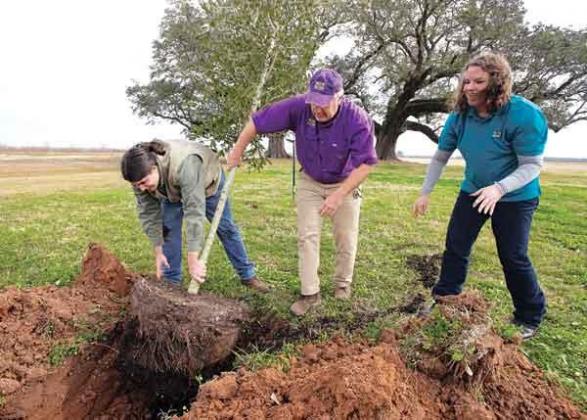
Olivia McClure
Anyone who has ever visited the LSU AgCenter Dean Lee Research and Extension Center or the neighboring campus of LSU Alexandria has probably noticed — and maybe even stopped to snap a photo of — a pair of huge live oaks that stand in a field behind an office building.
The trees are estimated to be between 250 and 300 years old. They’re an icon associated with the AgCenter facility and LSUA, appearing on numerous websites and publications.
But the famous oaks have sustained significant damage over the years. And with Louisiana Arbor Day coming up later this month, a group of AgCenter horticulture agents recently decided the timing was right to plant two new southern live oaks near the older trees.
“We felt it appropriate to continue the legacy of these magnificent oaks for this year’s Arbor Day,” said Tara Smith, director of the AgCenter Central Region. “The current oak trees in addition to our newly planted oaks will be a legacy for the entirety of the LSU community in central Louisiana for years to come.”
Central Region horticulture coordinator Sara Shields and agents Michael Polozola and Keith Hawkins planted the trees, which were donated by a nursery in Forest Hill, on Jan. 6. They took advantage of the occasion to record an instructional video, available online at https://youtu.be/azv0zsRl8Ls, for people interested in planting trees of their own this Arbor Day.
Louisiana celebrates Arbor Day on the third Friday of each January, which falls on Jan. 15 this year.
“January is an ideal month for planting hardy trees in Louisiana for several reasons,” Shields said. “The trees are dormant during this period, we generally receive adequate rainfall and the cooler weather reduces overall stress. The trees will have several months to acclimate before the warmer spring and summer months arrive.”
The agents have the following tips for choosing a tree to plant this Arbor Day:
— Consider the tree’s purpose. Do you want it to provide shade? Will it serve to enhance the space, perhaps as a focal point? Do you want the tree to provide year-round interest? Or perhaps you are looking for something to produce flowers or fruit to support local wildlife.
— Consider the retention of foliage. Some trees keep their leaves all year, while deciduous trees lose them in the winter.
— Consider the appropriate mature size. Generally, small trees will mature at a height of 15 to 25 feet. Medium-sized trees grow to 30 to 55 feet. Large trees can reach 60 feet and taller.
— Consider the surroundings of the intended planting area. Look around for powerlines, other trees and plants, structures, water lines and paved surfaces such as driveways and sidewalks. Large trees should be a planted a minimum of 15 to 20 feet from your house and paved surfaces.
— Consider local growing conditions. Select trees that can tolerate the heat and humidity of our summers, pH of native soil, soil type and water-holding capabilities of the soil.
\Once you’ve selected a tree, the agents suggest these steps for properly establishing it in your landscape:
— Dig a hole. It should be at least twice the diameter and no deeper than the height of the root ball.
— Remove the tree from its container. If the root ball is tightly packed, tilt the container and apply pressure to release it and the potting media from the container. If the root ball is tightly packed with thick encircling roots, try to unwrap, open up or even cut some of the roots to encourage them to spread into the surrounding soil.
— Place the root ball in the hole. The top of the root ball should be level with or slightly above the surrounding soil. Do not plant too deeply.
— Break up the native soil and return it to the planting hole. It’s not recommended to add any soil amendments at this time. Firm the native soil as it is added back to the planting hole.
— Water the tree thoroughly to settle the root ball and soil.
— Make a note to apply a slow-release fertilizer in the spring.
— Stake the tree if it is unstable. Stakes should be left in place for no more than nine to 12 months.
— Mulch the area. Keep the area 1 to 2 feet away from the trunk mulched and free of weeds and grass. The mulch should be about 4 inches deep and pulled back slightly from the base of the tree. Do not create a volcano-like shape with the mulch.
— Water a newly planted tree whenever the weather is dry. It is a good idea to track rainfall amounts and supplement if rainfall is inadequate. This is the most important step to ensuring a tree’s survival, especially during its first summer after planting. To properly water a tree in its first year, turn a hose on trickle. Lay the end on the ground within 6 inches of the trunk, and let the water trickle for 30 to 45 minutes. Do this twice a week during hot, dry weather.
A publication with additional information on choosing, planting and caring for trees is available on the AgCenter website at https://bit.ly/2MPi2Hi.
